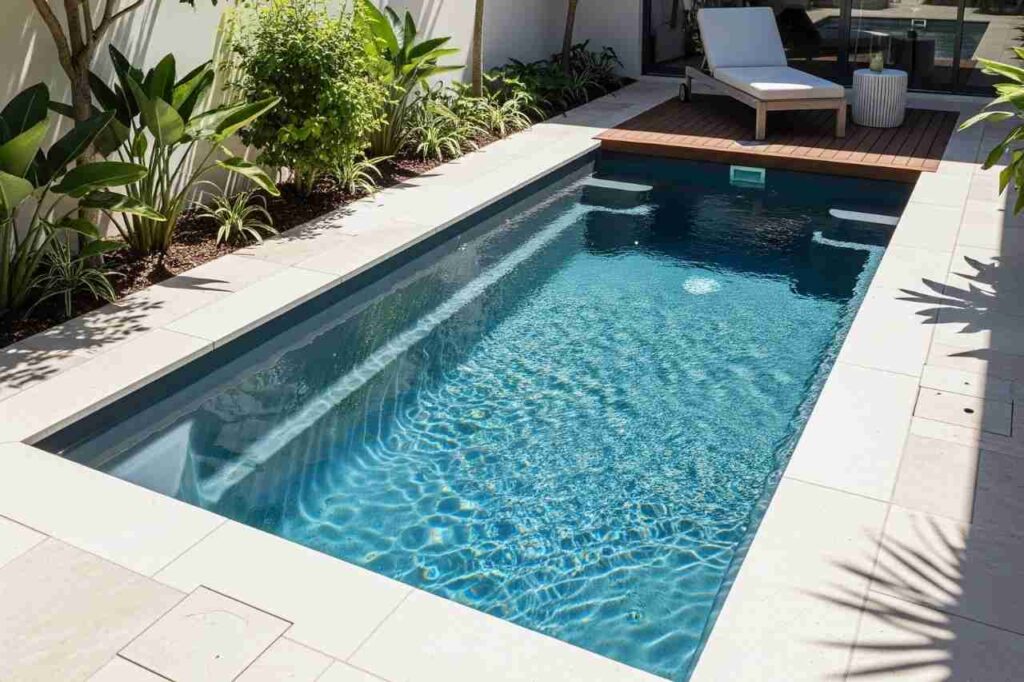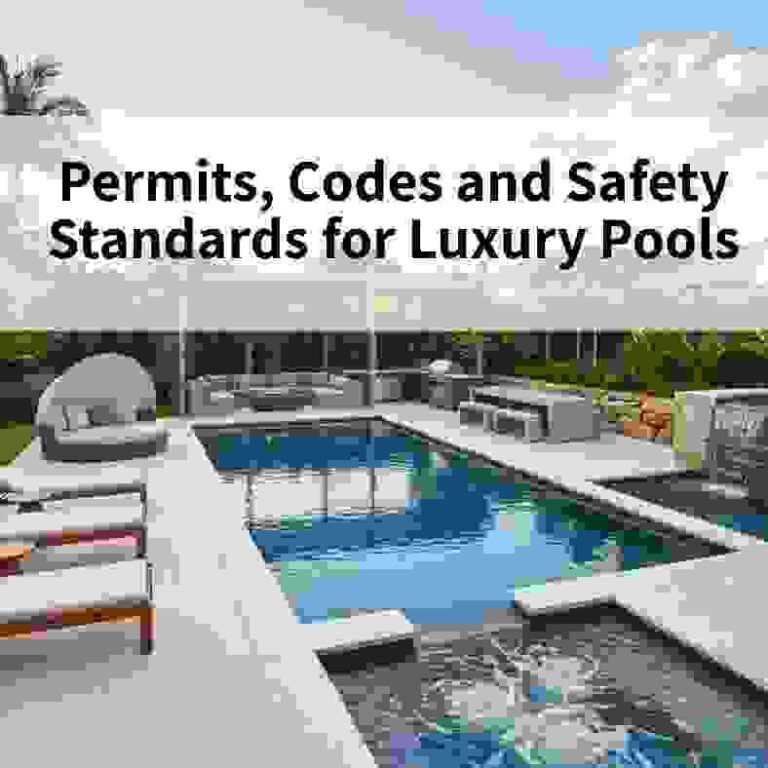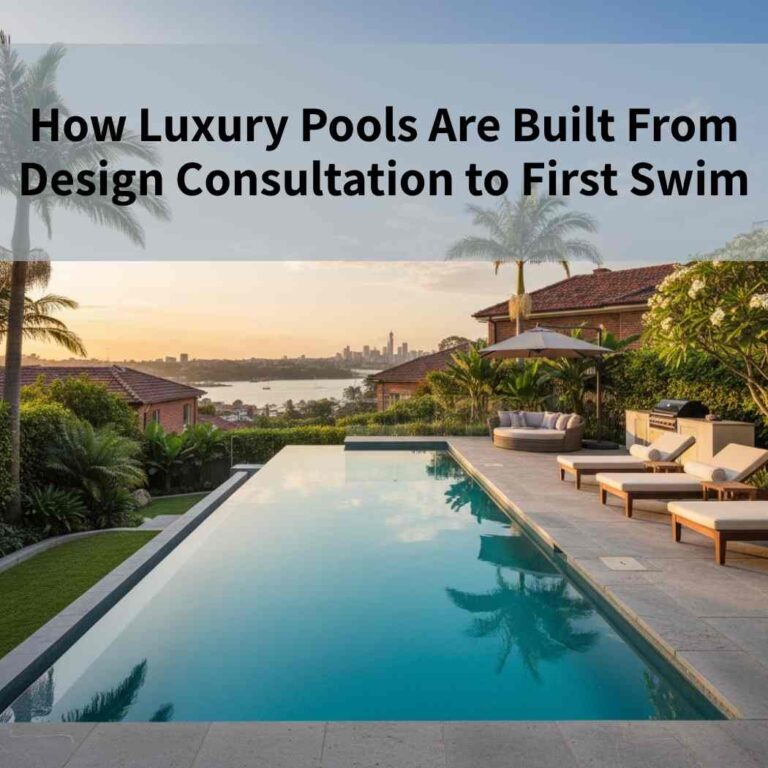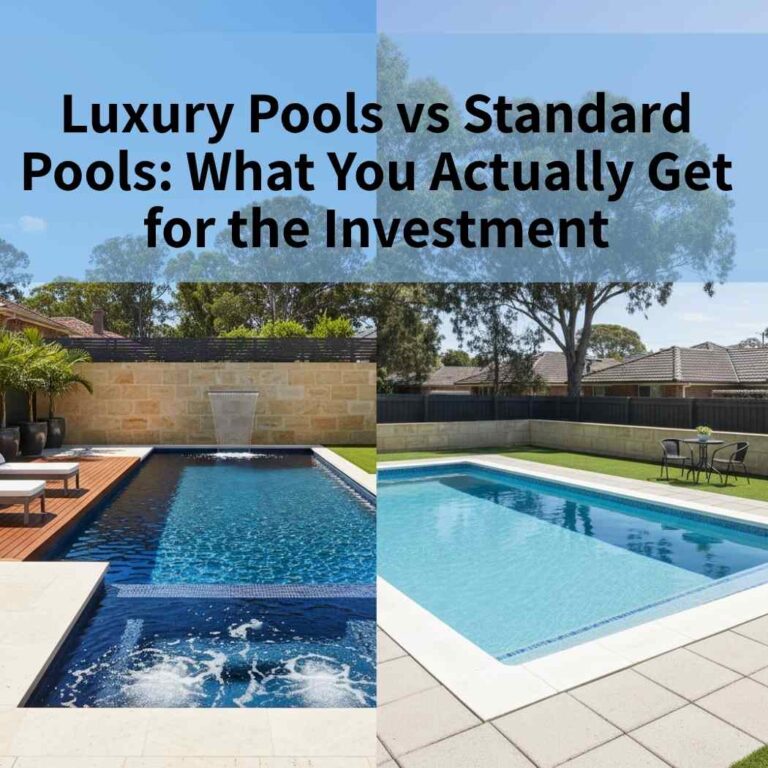We’ve helped Sydney homeowners turn even the smallest backyards into relaxing retreats with fibreglass plunge pools. Our team makes everything simple from design to council approval and installation so you can enjoy your pool without the stress.
In this guide, we’ll cover what fibreglass plunge pools are, how they work, what they cost, and why they’re such a popular choice in Sydney. Let’s start with the basics.
Table of Contents
ToggleWhat Are Fibreglass Plunge Pools?

Afibreglass plunge pool is a small, factory-made swimming pool built from fibreglass, delivered in one piece, and installed quickly in your backyard.
These pools are made in a factory under strict conditions, so the quality is consistent before they arrive at your home. The pool shell is built in strong layers:
- Gelcoat finish: Shiny outer layer that protects from the sun and makes cleaning easy.
- Fibreglass mats: Strong sheets that hold the pool’s shape.
- Vinyl ester resin: Stops water from seeping in and protects against chemicals.
- Polyester resin: Binds the layers together, making the shell strong and flexible.
This design makes fibreglass plunge pools tough, low-maintenance, and ideal for Sydney homes.
Why Fibreglass Pools Work Well With Sydney’s Clay Soil
Unlike concrete, fibreglass shells can flex with Sydney’s shifting clay soil, so they’re less likely to crack.
Sydney’s clay soil expands when it’s wet and shrinks when it’s dry. This movement can damage concrete pools over time. Fibreglass plunge pools are different — their layered shell can bend slightly without breaking, which makes them a safer choice for backyards built on reactive soil.
Basic Filtration and Heating Systems
Every fibreglass plunge pool needs a system to keep the water clear and comfortable. The main filter types are:
| Filter Type | Best For | Upkeep |
|---|---|---|
| Cartridge | Small yards | Rinse with hose |
| Sand | Heavy debris | Backwash as needed |
| Mineral | Softer, gentler water | Lower chlorine use |
For heating, Sydney homeowners usually choose one of three options:
- Solar heating: Uses rooftop panels, great in summer but less effective in winter.
- Electric heaters: Heat water quickly but cost more to run.
- Heat pumps: Energy-efficient and steady year-round, popular in Sydney.
Some pools also add extras like smart controls, spa jets, and LED lights for comfort.
How Do Fibreglass Plunge Pools Work?
Installation Process
A fibreglass plunge pool can usually be installed in just 2–4 weeks, much faster than a concrete pool. The steps are simple:
- Excavate the site – dig the hole to the right depth and shape.
- Deliver the pool shell – transport the prefabricated fibreglass shell to your home.
- Lower with a crane – carefully place the shell into position.
- Connect plumbing and power – hook up the pump, filter, and electrical systems.
- Backfill around the shell – use stabilising material like crushed rock or sand.
- Fill and test the pool – add water, check systems, and make final adjustments.
Low Maintenance
Fibreglass plunge pools are known for their low upkeep. The gelcoat surface is smooth and non-porous, making it resistant to algae growth and chemical staining. This reduces the need for frequent scrubbing and allows for lower chemical usage. Most pools require only basic weekly maintenance such as filter rinsing and water balancing.
Comfort Features: Jets and Lighting
Modern fibreglass plunge pools often include optional hydrotherapy jets and underwater LED lighting:
- Spa Jets: Powered by a separate pump, these jets circulate water at high velocity, providing therapeutic massage benefits. They are plumbed into the pool shell during manufacturing.
- LED Lighting: Installed within the shell’s walls, these lights use low-voltage transformers and can include colour-changing features. Most systems are controllable via remote or smart home integration.
These features are embedded during production and connected during installation, turning the plunge pool into a functional relaxation space.
Why Are Fibreglass Plunge Pools So Popular in Sydney?
Fibreglass plunge pools have become a go-to choice for Sydney homeowners seeking a balance of style, function, and practicality. Their popularity is driven by a unique mix of spatial efficiency, rapid setup, and minimal ongoing demands all tailored to the challenges of Sydney’s urban environment and reactive clay soils.
- Ideal for Compact Backyards
Whether it’s a terrace courtyard in Surry Hills or a narrow block in the Inner West, fibreglass plunge pools are perfectly sized to maximise outdoor space without sacrificing usability.
- Fast and Fuss-Free Installation
With a pre-moulded shell delivered to site and craned into place, most installations are completed in 2–4 weeks and it is ideal for families or renovators looking for fast turnarounds.
- Low-Maintenance Living
The non-porous gelcoat finish resists algae, biofilm, and staining, cutting down on scrubbing, chemicals, and cleaning systems. Homeowners enjoy more relaxation and less upkeep.
- Engineered for Longevity
Built to endure Sydney’s harsh UV conditions, heavy rains, and shifting soils, fibreglass plunge pools come with long structural warranties and require fewer repairs than concrete or vinyl alternatives.
Family Cases in Sydney
1. A Cameron family installed a compact 4x2m plunge pool to give their kids a safe splash space. With built-in seating and heating, it doubles as a spa in winter.
2. An Inner West couple added spa jets and mood lighting to create a personal retreat, turning their small backyard into a year-round sanctuary.
3. In Chatswood, a downsizing retiree chose a mineral plunge pool to manage joint pain through warm water therapy without taking up too much yard space.
Design Options & Landscaping
Sizes for Sydney Backyards
Most fibreglass plunge pools range from 4–6 metres long and 2–3 metres wide. This compact size makes them perfect for courtyards, patios, or garden corners.
Finish and Colour Choices
You can choose a finish to match your home and garden:
- Shimmering Colours: Infused with mica or quartz chips that glisten under sunlight.
- Stone Textures: Stone-inspired finishes that blend seamlessly with garden or coastal settings.
- Matte or Gloss Options: Suiting both contemporary and classic home aesthetics.
These surface options are UV-resistant, colourfast, and tailored for outdoor exposure in Sydney’s temperate climate.
Installation Styles
You can select from multiple installation types, based on site elevation and design preferences:
In-Ground: Flush with the backyard, offering a clean, minimalist look that integrates with lawns or paved areas.
Semi-Inground: Ideal for sloped blocks or yards with elevation changes, allowing for creative terraced landscaping.
Above-Ground: A practical solution for tight-access sites or where excavation is not possible; often paired with built-up decking.
Add-On Features
To personalise the space, most fibreglass plunge pool models are compatible with:
- Hydrotherapy Jets
- LED Mood Lighting
- Electric or Solar Heating Systems
- Smartphone Automation for Water Management
These extras can be incorporated at the time of install or retrofitted depending on the model.
Landscaping Ideas
A plunge pool’s real value comes from how well it fits into the broader outdoor living space. Here’s how Sydney homeowners are integrating them into their gardens:
- Timber or Composite Decking: Creates a resort-style platform around the pool and provides usable lounge space.
- Natural Stone Surrounds: Materials like travertine, granite, or bluestone elevate aesthetics and offer slip resistance.
- Frameless Glass Fencing: Maintains unobstructed views, complies with pool safety laws, and enhances modern garden designs.
- Privacy Planting: Bamboo, ornamental grasses, or pleached hedges provide a lush screen while softening the pool’s geometry.
These pool design choices not only improve the look and feel of the space but also help the pool become a natural extension of the home, especially important on compact Sydney blocks where outdoor zones need to serve multiple functions relaxation, entertaining, and visual appeal.
Comparing Fibreglass to Other Pool Types
Fibreglass vs Concrete Pools
| Factor | Fibreglass | Concrete |
|---|---|---|
| Install Time | Weeks | Months |
| Care | Low, smooth surface | High, porous surface |
| Design | Set moulds | Fully custom |
| Cost | Lower | Higher |
| Best For | Quick, easy upkeep | Large or unique builds |
Fibreglass vs Precast Plunge Pools
| Factor | Fibreglass | Precast Plunge |
|---|---|---|
| Weight | Light, easier to move | Heavy, needs machinery |
| Access | Good for tight sites | Difficult on narrow blocks |
| Install | Faster placement | Slower, crane required |
| Structure | Strong shell | Solid monolithic unit |
| Best For | Urban Sydney homes | Large open sites |
Fibreglass vs Above-Ground Modular Pools
| Factor | Fibreglass | Above-Ground Modular |
|---|---|---|
| Structure | Strong, durable shell | Steel/resin/timber frame + liner |
| Install | 2–4 weeks | 1–2 days |
| Portability | Permanent | Portable, can be disassembled |
| Durability | 25+ years | 5–10 years (liner/frame) |
| Best For | Long-term homeowners | Rentals or temporary use |
Above-ground modular pools are typically made from steel, resin, or timber frames with a vinyl liner. These pools are portable, easy to disassemble, and ideal for temporary or rental properties.
However, they often lack the aesthetic integration and longevity of fibreglass. Modular pools are:
- More affordable upfront.
- Easier to move or relocate.
- Limited in appearance visible external frames and liners often clash with landscaping.
- Less durable in long-term use, particularly in harsh sunlight or heavy-use environments.
In contrast, fibreglass plunge pools are a permanent, architecturally integrated feature that adds to property value and lifestyle appeal.
| Feature | Fibreglass | Concrete | Precast Plunge | Modular (Above-Ground) |
|---|---|---|---|---|
| Installation Time | 2–4 weeks | 3–6 months | 2–3 weeks | 1–2 days |
| Design Flexibility | Limited to moulds | Fully customisable | Limited designs | Modular shapes only |
| Cost (Initial) | $$ | $$$$ | $$$ | $ |
| Maintenance Level | Low | High | Medium | Medium |
| Surface Durability | 25+ years, gelcoat | 25+ years, porous | 25+ years, concrete | 5–10 years (liner/frame) |
| Aesthetic Integration | High | High | High | Low |
| Site Access Requirements | Moderate | High | Very High (heavy unit) | Minimal |
| Property Value Impact | High | High | High | Low |
Costs and Ownership in Sydney
What Does a Fibreglass Plunge Pool Cost?
In Sydney, the cost of a fibreglass plunge pool typically ranges from $25,000 to $40,000, including standard installation. Pricing depends on several key factors:
- Pool Size and Model
- Site Access (crane requirements, slope, fencing)
- Installation Type (inground, semi-inground, or above-ground)
- Optional Add-Ons: Heating systems, lighting, spa jets, mineral filtration, or pool automation.
Custom landscaping, decking, and fencing can significantly increase the total budget but also boost long-term property value and usability.
Running Costs: Low Maintenance, High Value
Fibreglass pools are cheaper to own long term than concrete because they use:
- Fewer chemicals
- Less electricity
- Minimal cleaning equipment
This makes them a cost-effective choice for Sydney families, downsizers, and busy homeowners who want a pool without constant upkeep.
What to Consider Before Buying
Use this pre-purchase checklist to guide your plunge pool decision:
Entry-level or full feature setup?
Is the space level, narrow, sloped, or corner-bound?
Can delivery trucks or cranes reach your yard?
Will your suburb need development applications or engineering reports?
Heating, spa jets, mineral water, LED lights, automation?
For resale, family life, or personal relaxation?
Regulations and Safety in Sydney
NSW Pool Safety Laws
All plunge pools in New South Wales must comply with the Swimming Pools Act 1992 and associated safety standards. This applies to both new and existing installations, including fibreglass models.
The core safety requirements include:
- A pool fence that is at least 1.2 metres high, with no climbable objects nearby.
- A self-closing, self-latching gate that opens outward and away from the pool.
- CPR signage that is clearly visible and compliant with Australian resuscitation guidelines.
- Registration with the NSW Swimming Pool Register prior to occupancy or use.
Regular inspections by council or private certifiers may also be required for compliance certification.
Council Approval and Compliance Support
Most Sydney councils require Development Approval (DA) or Complying Development Certificates (CDC) before pool installation can begin. The type of approval needed depends on:
- Proximity to boundaries or existing structures
- Zoning regulations
- Whether the property is in a heritage conservation area
Our team handles this approval process, providing support for paperwork, site plans, and engineer documentation to ensure you meet council timelines and legal obligations.
Local Considerations for Sydney Homeowners
1. Heritage and Conservation Areas
Suburbs such as Balmain, Paddington, and Hunters Hill have heritage overlays that can lead to longer approval times. Pools may need to be screened from street view, use specific materials, or follow landscaping guidelines. We coordinate with heritage consultants when required.
2. Crane Access in Tight Sites
In older Sydney suburbs like Newtown or Leichhardt, laneway or side yard access is limited. Fibreglass pools are often preferred because their lightweight shells can be craned in over the house or via compact lifting equipment. Concrete and precast alternatives may be too heavy or large for similar access.
3. Clay Soil Movement
Many areas in Sydney, especially north-west and inner-west suburbs, are built on reactive clay soil that expands and contracts with moisture. Concrete pools are prone to cracking under these conditions unless they use extensive reinforcement and deep footings.
Fibreglass plunge pools, on the other hand, are flexible and monolithic, allowing them to move slightly with ground shifts without breaking or leaking making them a superior option for clay-based properties.
Risks & Challenges of Fibreglass Plunge Pools
The main risks of fibreglass pools are fading, blistering, poor installation, and warranty limits but most can be avoided by choosing the right builder.
1. Gelcoat Fading or Discolouration
Over time, prolonged exposure to harsh UV rays and poorly balanced water chemistry can cause the pool’s gelcoat surface to fade or discolour. Cheaper finishes may also be more prone to chalking or yellowing.
Mitigation:
Choose a reputable manufacturer that uses UV-stabilised gelcoats rated for Australian conditions. Maintain correct water balance, particularly pH and chlorine levels, to prevent surface degradation.
2. Surface Osmosis (Blistering)
Osmosis occurs when water penetrates the fibreglass shell, creating small blisters beneath the gelcoat. Though less common in modern pools, it can happen in poorly manufactured or unsealed shells.
Mitigation:
Buy from brands with a proven track record and ask about anti-osmosis barrier layers. Proper curing and sealing during manufacturing greatly reduces this risk.
3. Improper Installation
Incorrect leveling, poor backfilling, or insufficient drainage can lead to structural shifting, surface warping, or plumbing issues particularly in reactive clay soils.
Mitigation:
Work withlicensed, experienced installers who understand local ground conditions. Inquire about geotechnical assessments and soil-specific backfill materials like crusher dust or stabilised sand.
4. Warranty Exclusions
Most fibreglass pools come with long structural warranties (often 25+ years), but fine print exclusions may apply especially for damage caused by improper chemical use, groundwater pressure, or DIY modifications.
Mitigation:
Read the warranty carefully. Ensure installation and maintenance follow manufacturer guidelines, and keep a record of service logs and water tests to protect your coverage.
A well-installed, high-quality fibreglass plunge pool can last decades but like any investment, it performs best when paired with proper care, the right expertise, and premium materials.
Conclusion
A fibreglass plunge pool is one of the smartest ways to add style, relaxation, and value to your Sydney home. They’re compact, durable, and easy to maintain making them perfect for today’s smaller backyards and busy lifestyles.
Ready to explore fibreglass plunge pools in Sydney? Our team can handle design, council approvals, and installation so you can enjoy your new pool sooner.
FAQs
How much does a fibreglass plunge pool typically cost to install in Australia?
In Australia, fibreglass plunge pools cost $25,000–$45,000 installed. The final price depends on pool size, site access, approvals, and extras like heating or decking. They’re usually cheaper and faster to install than concrete pools.
How long does a fibreglass plunge pool last, and what is the warranty usually like?
A well-maintained fibreglass plunge pool lasts 25–30 years. Most manufacturers offer up to 25 years on the shell and 5–10 years on the surface. Regular cleaning and balanced water chemistry help protect the gelcoat and extend its life.
Can a fibreglass plunge pool be customised in size, shape, or colour?
Yes, fibreglass plunge pools come in a range ofsizes, shapes, steps, and colour finishes. While not as fully customisable as concrete, you can still add extras like spa jets, lighting, heating, or mineral systems to match your backyard design.
What safety requirements apply to fibreglass plunge pools in Australia?
All plunge pools must follow the same laws as larger pools. This means a 1.2m fence, a self-closing gate, visible CPR signage, and registration with your local authority. Always check your state or council rules before installation.
Are there new design trends or technologies shaping the future of fibreglass plunge pools?
Popular trends include bench seating, spa jets, mineral water systems, and smart controls. Many homeowners also choose compact designs with LED lighting and energy-efficient heating for year-round use. Eco-friendly filtration is another growing feature.




